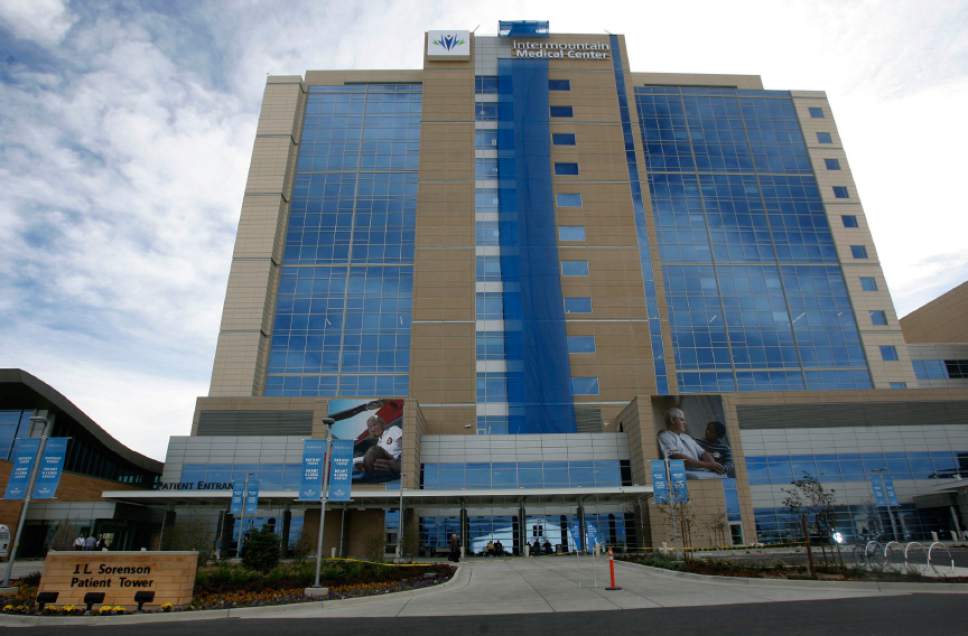This is an archived article that was published on sltrib.com in 2016, and information in the article may be outdated. It is provided only for personal research purposes and may not be reprinted.
Intermountain Medical Center is among eight Utah hospitals being penalized by the federal government for patient-safety problems.
The federal Centers for Medicare and Medicaid Services (CMS) this week identified 769 hospitals across the U.S. that had high rates of patient injuries. CMS will dock those hospitals 1 percent of the usual Medicare payments for patients discharged in the current federal fiscal year, which began Oct. 1 and runs through September.
In 2015, Intermountain Medical Center received $966 million in "patient services revenues" from Medicare, according to a March 2016 auditors' report.
Hospital-acquired conditions — developed when patients are being treated for an unrelated ailment — were examined by federal officials at 3,203 facilities across the U.S. The worst-performing 25 percent receive a reduction in payments.
The feds began penalizing hospitals this way in October 2014.
Six quality measures were examined in ranking hospitals, including health care-associated infection data — from surgical site infections after hysterectomies to catheter-related urinary tract infections — reported by licensed hospitals to the National Healthcare Safety Network. The number of infections reported to the network then is compared to the Centers for Disease Control and Prevention prediction for each facility, which is based on its size, volume of procedures and complexity of the conditions treated.
Data from the Agency for Healthcare Research and Quality —such as hip fractures, pressure ulcers and accidental punctures or lacerations — also is examined in ranking hospitals. The agency reported this month that hospital-acquired conditions in facilities across the country declined 21 percent between 2010 and 2015.
CMS did not respond to a request for comment.
Suzanne Anderson, a nurse administrator at Intermountain Medical Center, said in a statement Wednesday that they support "the concept of measuring and identifying hospitals" that provide quality care and connecting that to a "financial reimbursement incentive." However, she said the feds' attempt at this misses the mark.
"Our view is that this attempt by the federal government in applying the same prescribed methodology for calculating scores across all hospitals nationwide, despite their substantial variations in size and number of procedures performed, is flawed and there are clearly refinements and changes needed for the program," she said.
For example, Anderson said information used in these calculations always is at least a year old and doesn't "reflect real-time care provided to patients."
"Reductions in hospital-acquired conditions are a focus for the hospitals, and improvements are continually being made," she said.
Based on data reported to the network, Intermountain had higher than predicted surgical site infections after hysterectomies in 2015: Of the 306 hysterectomies performed at Intermountain last year, 12 resulted in surgical site infections. The CDC estimated that there would have been 5.79, according to a recent Utah Department of Health report.
Catheter-associated urinary tract infections also were higher than estimated at Intermountain. The center had 10,864 total days that a patient had a urinary catheter in adult and pediatric intensive care units in 2015, and there were 44 infections, the report states. The CDC estimated there would be 25.64 infections.
Intermountain officials previously told The Salt Lake Tribune that this is partly due to efforts to reduce the number of days patients use catheters.
"Hospitals devoting serious resources to safer care with optimized surveillance tend to lead to increased detection versus less safe care," Anderson said. "These facilities are being penalized."
St. Mark's Hospital, LDS Hospital and Salt Lake Regional Medical Center, all in Salt Lake City, also were on the list to receive a payment reduction from the feds. Other listed hospitals were:
• Cache Valley Hospital, North Logan
• McKay Dee Hospital, Ogden
• Castleview Hospital, Price
• Mountain West Medical Center, Tooele
Based on 2015 data reported to the network, St. Mark's was on par with CDC estimates in all areas examined, from catheter-associated urinary tract infections to surgical site infections after a colonoscopy.
Marie Prothero, executive director of quality improvement at the hospital, said in a statement that they are "proactively addressing [patient safety] at St. Mark's; in part by evaluating the effectiveness of patient safety protocols throughout the hospital and taking steps to improve them."
Twitter: @alexdstuckey —
Utah hospitals among the nation's worst-performing 25 percent:
Intermountain Medical Center, Murray
Cache Valley Hospital, North Logan
McKay Dee Hospital, Ogden
Castleview Hospital, Price
LDS Hospital, Salt Lake City
Salt Lake Regional Medical Center, Salt Lake City
St. Mark's Hospital in Salt Lake City
Mountain West Medical Center, Tooele



